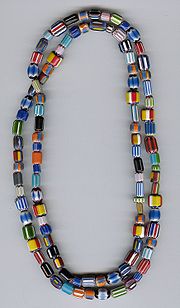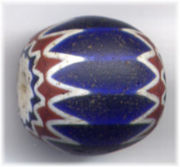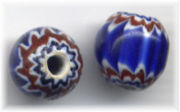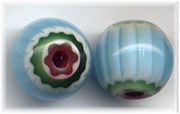
Chevron bead
Encyclopedia

Bead
A bead is a small, decorative object that is usually pierced for threading or stringing. Beads range in size from under to over in diameter. A pair of beads made from Nassarius sea snail shells, approximately 100,000 years old, are thought to be the earliest known examples of jewellery. Beadwork...
s, the first specimen
Specimen
A specimen is a portion/quantity of material for use in testing, examination, or study.BiologyA laboratory specimen is an individual animal, part of an animal, a plant, part of a plant, or a microorganism, used as a representative to study the properties of the whole population of that species or...
s of this type were created by glass bead makers in Venice
Venice
Venice is a city in northern Italy which is renowned for the beauty of its setting, its architecture and its artworks. It is the capital of the Veneto region...
and Murano
Murano
Murano is a series of islands linked by bridges in the Venetian Lagoon, northern Italy. It lies about 1.5 km north of Venice and measures about across with a population of just over 5,000 . It is famous for its glass making, particularly lampworking...
, Italy
Italy
Italy , officially the Italian Republic languages]] under the European Charter for Regional or Minority Languages. In each of these, Italy's official name is as follows:;;;;;;;;), is a unitary parliamentary republic in South-Central Europe. To the north it borders France, Switzerland, Austria and...
, towards the end of the 14th century. They may also be referred to as Rosetta, or star beads. The term rosetta first appeared in the inventory of the Barovier Glass works in Murano, in 1496, in context with beads as well as with other glass objects.
Venetian chevron beads are drawn beads, made from glass canes which are created in specifically constructed star moulds. The first chevron beads were made towards the end of the 15th century, consisting of 7 layers of alternating colours. They usually have 6 facet
Facet
Facets are flat faces on geometric shapes. The organization of naturally occurring facets was key to early developments in crystallography, since they reflect the underlying symmetry of the crystal structure...
s. Unlike their later counterparts they were not always made with the standard 12-point star mould. By the beginning of the 20th century, 4 and 6-layer chevron beads appear on various sample cards. According to records kept at the Societa Veneziana Conterie of Murano, they stopped making chevron canes during the 1950s. Chevron beads are still being made in Venice today, albeit in very small quantities only.
Chevron beads can be composed of a varied number of consecutive layers of colored glass
Glass
Glass is an amorphous solid material. Glasses are typically brittle and optically transparent.The most familiar type of glass, used for centuries in windows and drinking vessels, is soda-lime glass, composed of about 75% silica plus Na2O, CaO, and several minor additives...
es. The initial core is formed from a molten ball of glass (called a "gather") that was melted in a furnace. If the glassworker is making beads, an air bubble is blown into the center of the gather via a blowpipe, thus creating an opening, the future bead's perforation. When making solid multilayered cane intended to be used for decorating millefiori
Millefiori
Millefiori is a glasswork technique which produces distinctive decorative patterns on glassware.The term millefiori is a combination of the Italian words "mille" and "fiori" . Apsley Pellatt was the first to use the term "millefiori", which appeared in the Oxford Dictionary in 1849...
beads, no air bubble is inserted. The gather (with the air bubble in its center) is plunged into a star-shaped mould, which can have anywhere between five and fifteen points. Several layers of glass can be applied, returning to the mould as desired, to create either a star-shaped or smooth effect for each layer. After all layers have been applied, metal plates are affixed to the still hot glass, which is "drawn" or stretched out into a long rod, called a "cane", by pulling from both ends in opposite directions. The bubble at the center of the gather stretches with the cane and forms the hole in the bead, i.e. the bead's perforation. The diameter of the cane, and therefore of the resulting beads, is determined by the amount of glass in the original gather and also by how thin the glass is drawn out. The cooled glass cane is cut into short segments which reveal a star pattern in cross-section. The segments may be beveled or ground, to reveal the characteristic chevron pattern from which the English name is derived. The chevron pattern becomes apparent after the beads' ends have been ground. Only rosetta/star beads with ground ends (either faceted, rounded, or chamfered), and with their inner layers exposed, are "chevron" beads. All star beads with flat ends are more aptly termed rosetta/star beads.

West Africa
West Africa or Western Africa is the westernmost region of the African continent. Geopolitically, the UN definition of Western Africa includes the following 16 countries and an area of approximately 5 million square km:-Flags of West Africa:...
, where they were first introduced by Dutch merchants in the late 15th century. Certain very small sized 7 layer Venetian chevron beads, also made during the late 15th century, are found exclusively in the Americas, mainly in Peru
Peru
Peru , officially the Republic of Peru , is a country in western South America. It is bordered on the north by Ecuador and Colombia, on the east by Brazil, on the southeast by Bolivia, on the south by Chile, and on the west by the Pacific Ocean....
, and attributed to having been introduced by Christopher Columbus
Christopher Columbus
Christopher Columbus was an explorer, colonizer, and navigator, born in the Republic of Genoa, in northwestern Italy. Under the auspices of the Catholic Monarchs of Spain, he completed four voyages across the Atlantic Ocean that led to general European awareness of the American continents in the...
. Chevron beads are very popular collectors' items and they are still highly valued in present day West Africa, where they continue to be worn for prestige and ceremonial purposes, and occasionally buried with the dead. Chevron and rosetta/star beads are now also being manufactured in India
India
India , officially the Republic of India , is a country in South Asia. It is the seventh-largest country by geographical area, the second-most populous country with over 1.2 billion people, and the most populous democracy in the world...
and in China
China
Chinese civilization may refer to:* China for more general discussion of the country.* Chinese culture* Greater China, the transnational community of ethnic Chinese.* History of China* Sinosphere, the area historically affected by Chinese culture...
.


The probably best known contemporary chevron bead makers are the chevron pioneer Art Seymour, from the United States
United States
The United States of America is a federal constitutional republic comprising fifty states and a federal district...
, who has made chevron beads consisting of up to 19 layers, and Luigi Cattelan, from Murano, Italy. Chevron and rosetta/star beads can now be found in many different color combinations.

